If you want high-impact home décor without buying expensive pillows, crochet covers are the fastest way in. They’re portable, forgiving, and let you swap looks seasonally. Below you’ll find five modern pillow patterns — each with a clear skill level, full materials list, exact step-by-step construction, finishing and styling tips, plus troubleshooting and care. I’m not sugarcoating: some bits take patience (seams, neat edges), but every pattern is doable if you follow the steps and count carefully. Let’s make useful, attractive cushions you’ll actually keep on the sofa.
1. Crochet Sweet Bolster Pillow Pattern
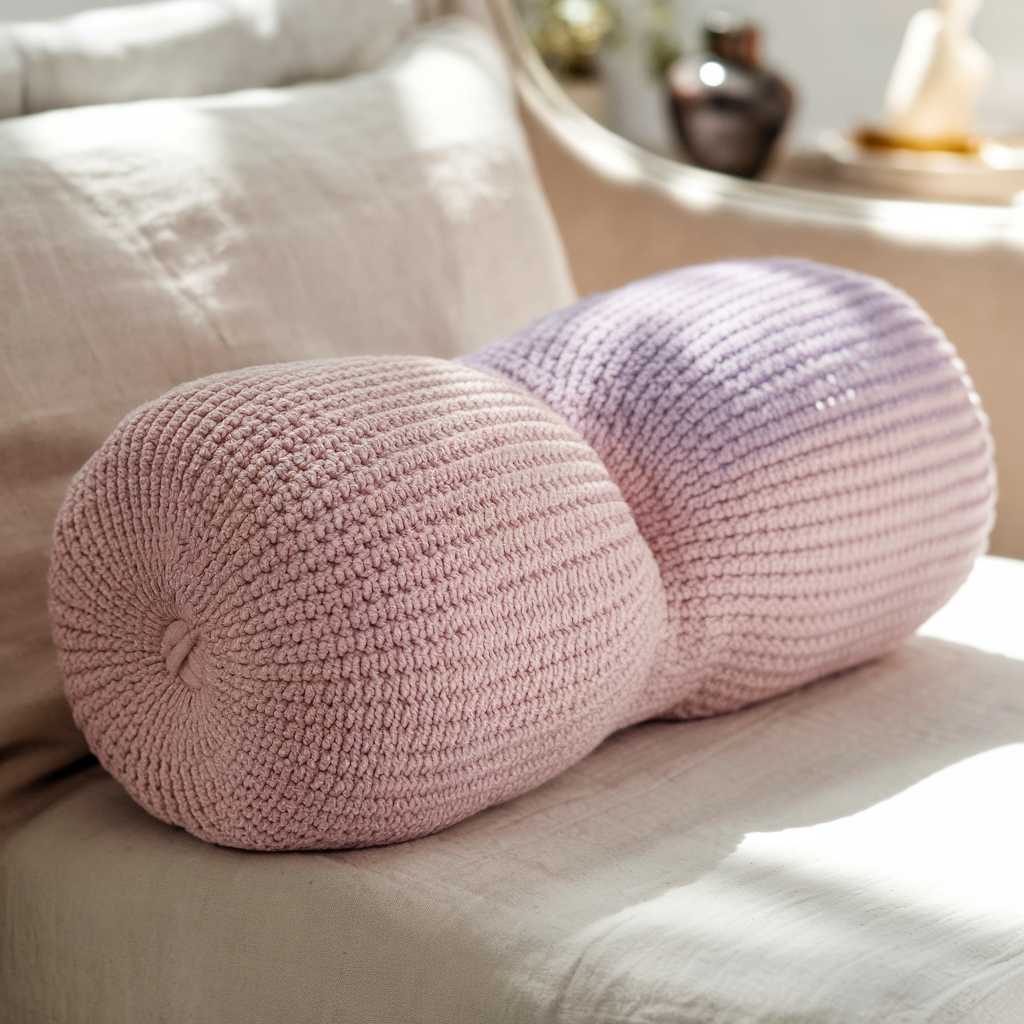
Overview: A streamlined bolster (tube) cushion cover for a modern bed or bench. Simple construction, subtle texture, and neat ends make this a quick win.
Skill level: Confident Beginner — comfortable with basic stitches (sc, hdc, dc), working in rounds and seaming.
Finished size: Fits a standard 12″ × 5″ bolster insert; adjust stitch count to fit other sizes.
Materials
- DK weight yarn, approx. 400–500 yds (acrylic, cotton, or cotton blend). Choose yarn that blocks lightly for smooth finish.
- 3.5–4.0 mm hook (use hook that gives you fabric with good drape but no big gaps)
- Tapestry needle, stitch marker
- 12″ × 5″ bolster insert or polyfill + core
- Optional: zipper or button/loop if you want removable cover
Abbreviations
- ch — chain
- sc — single crochet
- hdc — half double crochet
- dc — double crochet
- st(s) — stitch(es)
- sl st — slip stitch
- BLO — back loop only
- inc — increase (2 sc in same st)
Gauge (approx.)
16 sc × 18 rows = 4″ in sc (adjust hook if needed).
Notes
- This pattern is worked in the round for the tube body then flat for end circles (joined). If you prefer, make two flat rectangles and seam long edges.
- Measure your insert; you want the cover about ¾” smaller in circumference for a snug look.
Step-by-step instructions
Body (worked in the round)
- Measure the circumference of your insert: for a 12″ × 5″ insert, aim for ~34–36 sts in your round (this will vary by gauge). Determine a multiple that matches gauge. Example: if gauge gives 4″ = 16 sc and you need 34″ circumference → 34 ÷ 0.25 = 136 sts — this is an exaggerated calculation; instead use gauge to find stitches per inch then multiply. (Practical approach: make a 4″ swatch, count sc per inch, multiply by circumference.)
- Ch enough to join without twisting to reach desired circumference (or make a foundation sc round): join with sl st into first ch. Place marker.
- R1–R??: sc (or alternating sc/hdc rows for texture) around, working in continuous rounds or join & ch1 each round — your choice. Work until tube length equals insert length minus ~1″ (for end seaming). For a 12″ insert, work to 11–11.25″.
- Tip: If using continuous rounds, move stitch marker every 10 rounds to keep track.
- For a textured look: alternate 2 rounds sc, 2 rounds BLO hdc to create subtle ribbing.
End circles (make 2)
- Make a magic ring or ch 4 join to form ring.
- R1: 6 sc in ring — 6 sts.
- R2: inc around (12 sts).
- R3: sc, inc around (18 sts).
- Continue increasing evenly until circle diameter ≈ 5″ (to match the tube circumference; you may need 6–8 increase rounds depending on yarn/hook). Keep stitches even — increase placement determines flatness.
- Make two identical circles.
Assembly
- Place one circle at one end of the tube, right sides together. Whipstitch or mattress stitch around, leaving center gap large enough to insert bolster. Turn right side out.
- Insert the bolster: either slip in insert fully or stuff polyfill. If using dried lavender/scent, place in a small inner pouch before inserting.
- Attach second circle and seam closed. If you want a removable cover, instead seam only three sides, insert, and finish with zipper or button closure technique:
- Option: Instead of fully seaming, crochet a row of button-loop holes before final seam and add buttons on one half for removable cover.
Finishing
- Weave in ends. Steam-block lightly (careful with synthetic yarn).
- For tufted look: before final seam, thread tapestry needle with contrasting yarn and pull through center, tie to form shallow gathering.
Variations
- Add stripes by changing color every 6–8 rounds.
- Make ends in contrasting color or textured shell stitch.
- Use worsted yarn + larger hook for a chunkier bolster.
Troubleshooting
- If circle puckers: your increases are too close — add an extra sc between increases.
- If tube is too loose: decrease hook size one step or add an extra round of sc.
Care
- Machine wash gentle for acrylic/cotton blends; air-dry flat to preserve shape. Follow yarn label.
2. Crochet Bohemian Pillow Pattern
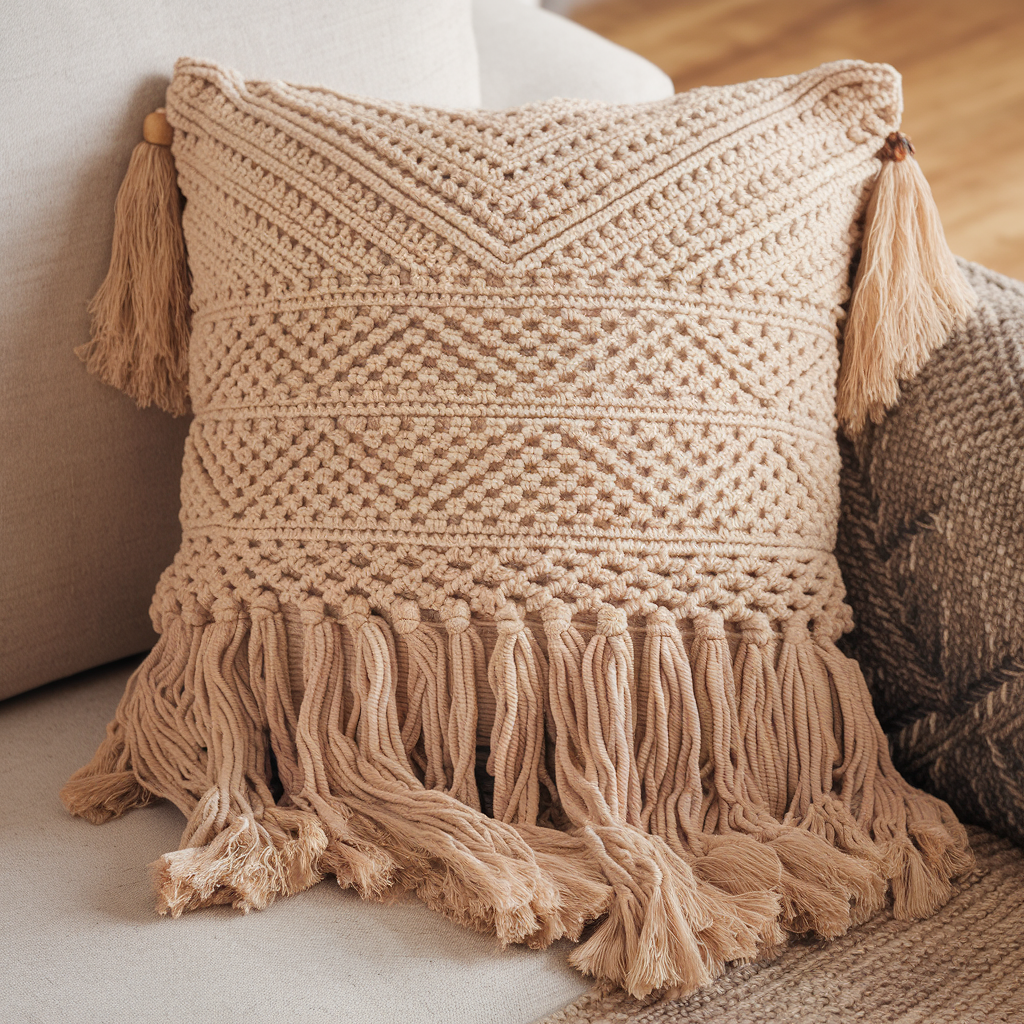
Overview: A cozy 18″ square pillow cover with boho texture—macramé-inspired fringe, openwork panels, and a central textured motif. Statement piece for sofas and floor seating.
Skill level: Intermediate — comfortable with filet/openwork, post stitches, fringe finishing.
Finished size: 18″ × 18″ pillow cover (fits 18″ insert).
Materials
- DK or aran weight yarn, approx. 500–700 yds (cotton-blend gives good drape).
- 4.0 mm hook (or size for gauge)
- Tapestry needle, stitch markers
- 18″ pillow insert
- Scissors, comb for fringe
Abbreviations
- ch, sc, hdc, dc, tr — treble (or tr in your region), sl st
- fpdc — front post double crochet
- bpdc — back post double crochet
- ch-sp — chain space
Gauge
14 dc × 10 rows = 4″ (varies by stitch; swatch recommended).
Design Notes
- Constructed as two panels (front with motif + fringe, back plain or envelope), then seamed.
- The front features three horizontal bands: textured center (post stitches), openwork band (lacier), and solid bands.
Step-by-step instructions
Front Panel (18″ wide)
- Foundation: ch enough to reach 18″ width using gauge. Example: if gauge is 4 dc = 1.5″, calculate dc per inch. Practical method: make a reference swatch and count stitches per inch, then multiply by 18.
- Row 1: dc across (turn).
- Row 2–6 (Bottom solid band): ch 3 (counts as dc), dc across. Repeat until 1.5″–2″ tall.
- Openwork band (lace): Row A: ch 3, dc in next st, ch1, skip 1 across to create airy mesh — repeat for desired height (1″–1.5″).
- Center textured band (focal): use fpdc/bpdc pattern to create raised diamond or chevron texture:
- Example textured repeat (over multiples of 6 sts): Row 1: fpdc around next 2 sts, bpdc around next 2 sts, repeat to end. Alternate rows to create ribbed chevrons. Work 3–4″ tall.
- Repeat openwork and top solid band to mirror bottom.
Back Panel
- Option A (Envelope): Make two panels: one 12″ tall and another 6″ tall (overlap) so they form an envelope. Alternatively add buttons or zipper.
- Option B (Full back): Make full 18″ square and close with zipper or hidden closure.
Fringe & Embellishments
- Cut multiple 8″ lengths of yarn, fold in half, and pull through edge stitches along the top/bottom or the sides to create boho fringe.
- Comb fringe gently to fluff, trim to even length.
Assembly
- Place front and back right sides together. Single crochet or slip stitch around 3 sides leaving one side for insert or use mattress stitch for neat seam.
- Insert pillow. Close final side with invisible seam or join with decorative buttons.
Finishing touches
- Add wooden beads to some fringe strands for boho detail.
- For extra depth, embroider small accents with contrasting yarn.
Troubleshooting
- If your panel keeps curling: add a few rows of sc around edges as a border to stabilize.
- Fringe too heavy: reduce length or number of strands.
Care
- Cotton blends: machine wash gentle, dry flat; avoid hot dryers to prevent shrinkage.
3. Crochet Granny’s Diamond Cushion Pillow Pattern
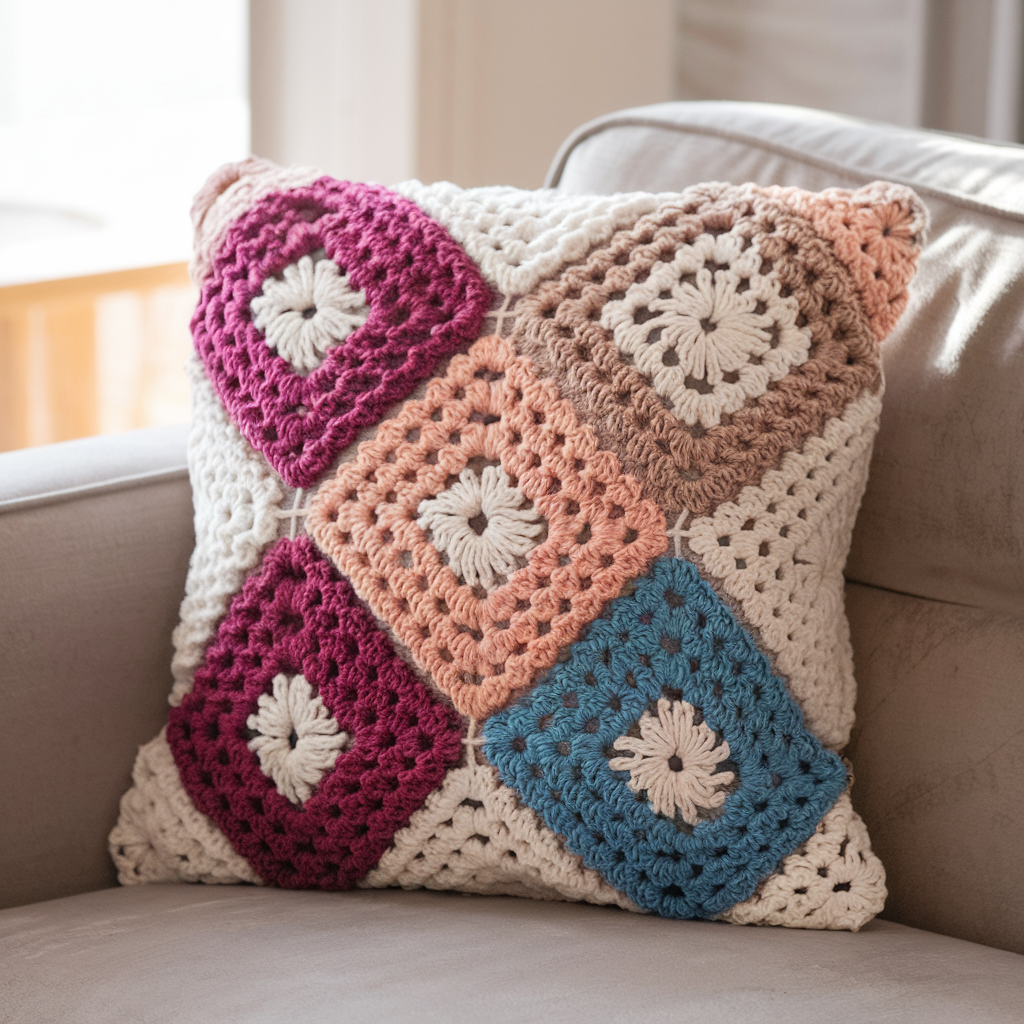
Overview: A modern twist on the classic granny motif — diamond-shaped granny squares joined to make a bold cushion cover. Perfect for color play and textures.
Skill level: Confident Beginner / Intermediate — basic cluster/granny stitches and joining methods.
Finished size: 16″ × 16″ cushion (made from 4 large diamond motifs arranged in a square), or scale up/down by changing motif size.
Materials
- DK yarn in 3–5 colors, 350–500 yds total.
- 4.0 mm hook (or hook to match yarn/gauge)
- Tapestry needle, blocking mat (recommended)
- 16″ pillow insert
Abbreviations
- ch, sl st, dc cluster (granny: usually 3 dc cluster), st(s), sp (space)
Motif notes
- Diamond motif is just a square granny worked into a diamond orientation by turning the square 45° when placing. We’ll work “diamond granny” from center out.
Step-by-step instructions
Large Diamond Granny (make 4)
- Foundation: Begin with a magic ring or ch 4 joined.
- Round 1: ch 3 (counts as dc), 2 dc in ring, ch 2, 3 dc in ring, ch 2 repeat twice more, join with sl st to top of ch3. (You have 4 clusters separated by ch-2 corners.)
- Round 2: In each ch-2 corner: (3 dc, ch 2, 3 dc). Between corners on sides: ch 1, 3 dc clusters (depending on width) — essentially you’re creating clusters that expand each side. Work until motif measures approx. 8″ from point to point (to create large diamond).
- Increase rounds evenly: each round adds clusters along the sides; keep corners as (3 dc, ch2, 3 dc).
- Change colors every 2–3 rounds for stripes of color. Fasten off and weave in ends.
Blocking (important)
- Block each motif to the same dimensions so joins are clean — pin to shape and spritz, let dry.
Join motifs
- Arrange four diamonds with points meeting at center to form square. Use whipstitch or mattress stitch to join right sides together. For a decorative join, use join-as-you-go method: when working final round of last motif, join into adjacent motif with sl sts and create a neat seam.
- Add an outer border: sc or crab stitch around outside edges to square up the whole piece and stabilize.
Back panel
- Make a full 16″ square back in dc or granny rows, or make a simple plain panel and add a zipper or envelope closure.
Assembly
- With right sides together, seam three sides with slip stitch or mattress stitch, insert pillow, and close final side.
- For removable cover, add a zipper before final seaming: install zipper along one side then seam remaining sides.
Styling & color tips
- Choose a dominant color + 2 contrasting accent colors. For modern look, pick one neutral (cream/gray) plus one saturated color and a muted tone.
- Use tonal shifts in the rounds for subtle ombré diamond.
Troubleshooting
- Diamonds not matching at seams: block motifs and count rounds — ensure each motif has same number of rounds.
- Gaps at center: make sure tension is consistent; use join-as-you-go for tighter center.
Care
- Wash gently; block again after washing if needed to maintain motif geometry.
4. Crochet Modern Granny Square Pillow Pattern
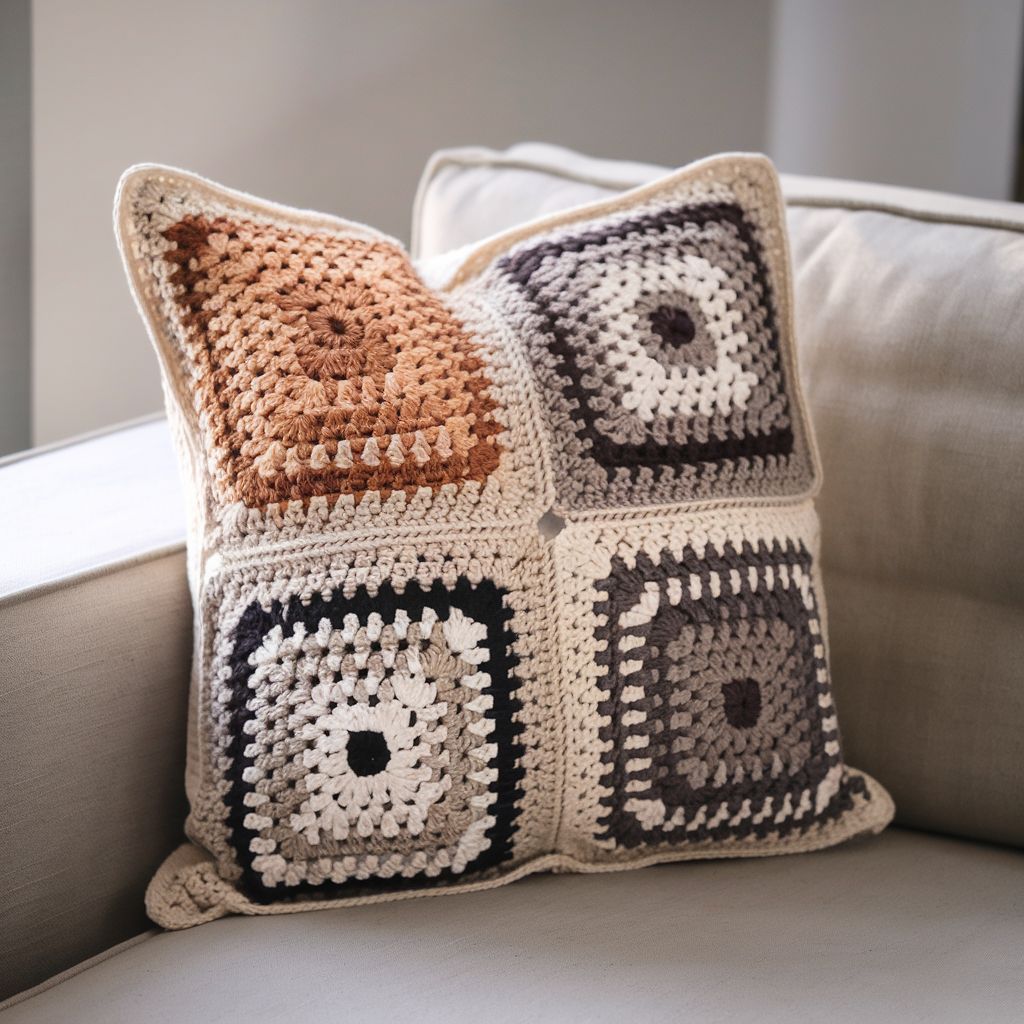
Overview: Classic granny square assembled into a modern, minimalist cushion—works in any size. This version uses large granny squares with contemporary color blocking and a sleek border.
Skill level: Confident Beginner — granny squares and standard finishing.
Finished size: 20″ × 20″ pillow (4 large granny squares, each ~10″).
Materials
- DK or worsted yarn depending on desired texture, 600–800 yds.
- 4.0–5.0 mm hook (match yarn)
- 20″ insert, tapestry needle, optional zipper
Abbreviations
- ch, sl st, dc cluster (3 dc cluster with ch1 between clusters)
Notes
- Large granny squares reduce join seams and speed assembly.
- Border can be modern (clean sc edging) or decorative (shell stitch).
Step-by-step instructions
Large Granny Square (make 4)
- Start with magic ring.
- Round 1: ch 3, (2 dc, ch1) × 3, 3 dc into ring, ch1, join. (4 clusters with ch1 corners)
- Round 2: In each ch1 corner, (3 dc, ch1, 3 dc); between corners, ch1, 3 dc cluster into ch1 space from previous round. Repeat to desired size — for 10″ squares, you may need 6–8 rounds depending on hook/yarn.
- Color changes: choose large blocks of color—2–3 rounds per color for modern stripes.
Joining
- Use visible join for modern look: slip-stitch join with contrasting yarn to create a gridline effect.
- Place squares right sides together and sl st through both loops along join (or join as you go).
- Add a border: once four squares joined into a big square, work 1–2 rounds of sc to even edges, then 2–3 rounds of hdc or extended stitches for plush feel.
Back panel & closure
- Make back panel plain in dc/hdc or make two panels for envelope closure (overlap 4–6″).
- For zipper: seam three sides, insert zipper, finish last side.
Finishing
- Weave ends into the border so they’re hidden but secure.
- Consider subtle tufting: thread through center and knot on inside with short tail.
Styling
- For a modern look: use 1 neutral + 1 pop color, or a monochrome tonal palette.
- For farmhouse/modern-mix: use natural yarns plus a burnt-orange or teal accent.
Troubleshooting
- Uneven square sizes: block and add rounds to smaller ones to match.
- Bulky joins: use thinner yarn for joins or use mattress stitch for flatter seam.
Care
- Follow yarn instructions; avoid hot dryer when using natural fibers.
5. Crochet Christmas Snowflake Pillow Pattern
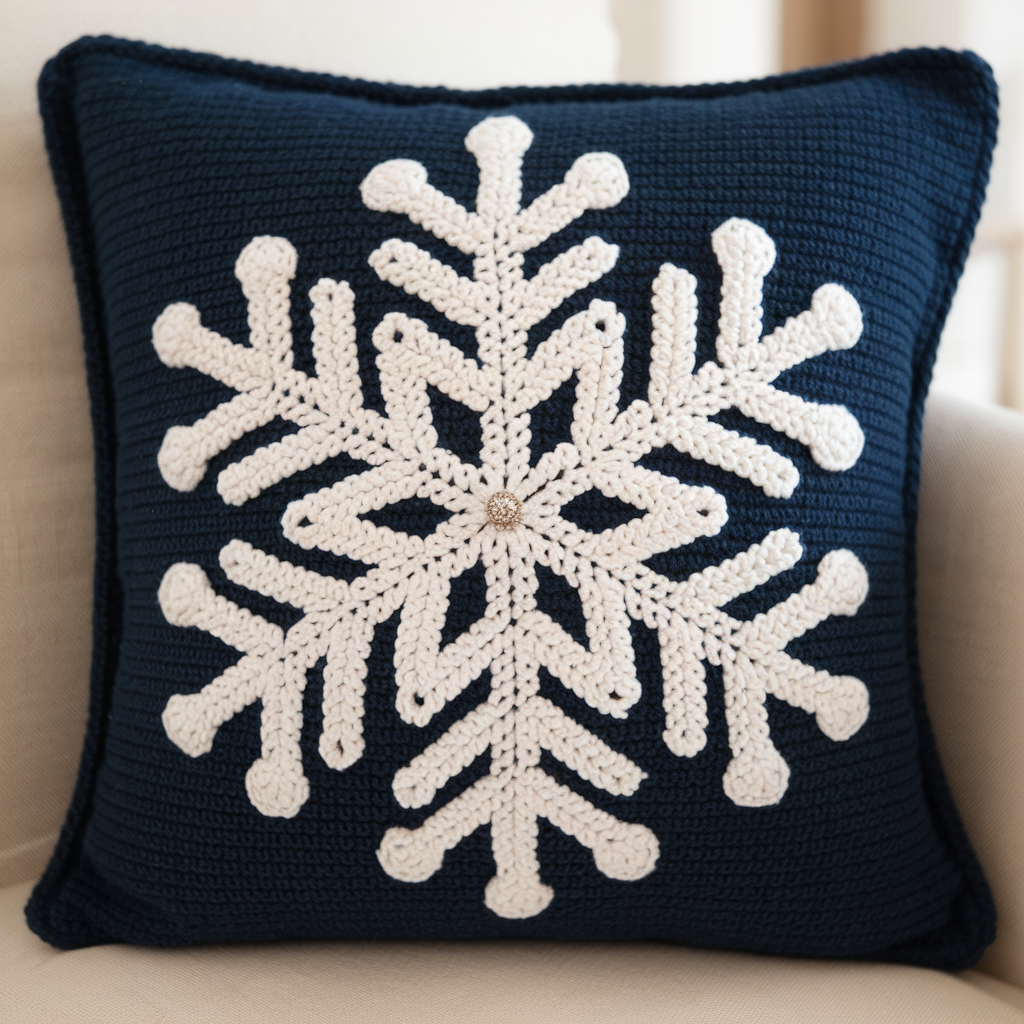
Overview: A seasonal 16″ square pillow featuring a raised snowflake motif in the center built with post stitches and layered applique. Festive but refined — works year after year.
Skill level: Intermediate — post stitches, motif applique, clean finishing.
Finished size: 16″ square.
Materials
- DK or aran yarn in white (snowflake) and background color (navy, grey, or deep green), ~400 yds total.
- 4.0 mm hook (or matching yarn)
- Tapestry needle, blocking pins
- 16″ pillow insert
Abbreviations
- ch, sl st, sc, hdc, dc, fpdc, bpdc, tr
- FLO — front loop only (optional for texture)
Design notes
- Work base square in solid color; make appliqué snowflake separately and sew on for a raised look.
- Snowflake can also be worked as post-stitch raised motif directly on the square if you prefer.
Step-by-step instructions
Base Square (16″)
- Ch enough for 16″ width; or make a granny/square of desired size. Example: ch 42 (adjust by gauge).
- R1: dc across. R2–R??: dc for about 8–9″ to make a square. Add sc border 1 round for neat edge.
Snowflake Appliqué
- Make a center ring: magic ring or ch 6 join.
- Round 1: ch 3 (counts as dc), dc, ch2, dc repeat 6 times total for 6 points — join.
- Round 2: In each ch2 corner: (ch3, tr, ch3) to extend point; add picots as decorative tips if desired: (dc, ch3, sl st in last ch).
- Round 3 (arms/detail): Attach white yarn at base of each point and work chains and single dc clusters to form branch details. Use fpdc/bpdc behind to raise some branches for shadowed depth.
- Block snowflake flat so points are crisp.
Attach appliqué to base
- Position snowflake centrally on the square. Pin in place.
- Use small whipstitches with white yarn to sew around interior points; keep stitches invisible on top.
- Optional: add a small button or metallic bead at center for sparkle.
Alternative: Raised Post Stitch Snowflake
- On base square, mark center. Work post stitches (fpdc) radiating out to form arms, building height by stacking fpdc rounds, and fill center with dc clusters. This method creates integrated texture.
Back & Assembly
- Make back panel as envelope or full panel with zipper.
- Place front and back right sides together; seam leaving opening or insert zipper.
- Insert pillow insert and close.
Finishing & Embellishments
- Add metallic thread sparingly for shimmer (use with care — can snag).
- For a subtle holiday look, edge with a row of crab stitch in white.
Troubleshooting
- Snowflake edges curl: block thoroughly and use a few stabilizing stitches at points.
- Appliqué puckers: use small, even stitches and avoid pulling too tight.
Care
- Hand wash recommended for embellished cushions; air dry flat.
Conclusion
Pick the pattern that matches your skill and the room you’re changing. Before you start a full cover: swatch, measure, and block. Those three actions cut your rework in half.
Quick checklist to finish any pillow well:
- Choose yarn and hook, then make a 4″ swatch and count stitches/rows per inch.
- Adjust stitch count so the finished cover has about 5–10% negative ease (slightly smaller than the insert) for a tidy, plump look.
- Block motifs/panels to consistent size before joining — don’t skip this.
- Join seams with a flat method (mattress stitch or join-as-you-go) for neat edges.
- Add your closure (envelope, zipper, buttons) before final seaming if you want a removable cover.
- Finish: weave ends, steam-block lightly if yarn allows, then insert and fluff.
- Care: follow yarn label; hand-wash embellished pieces, machine-wash plain cotton on gentle, air-dry flat.
Bottom line: accuracy (gauge + blocking) and neat finishing matter more than fussy stitches. Do those well and even a simple granny square will look designer on your sofa.


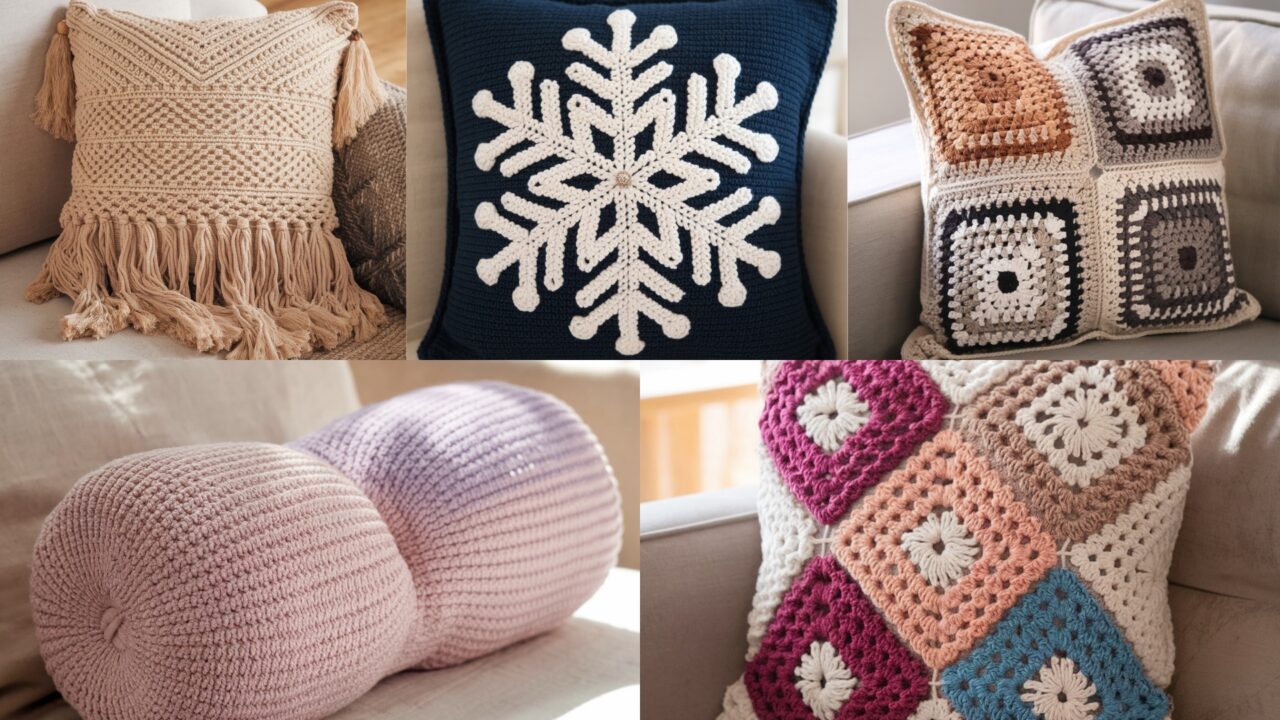
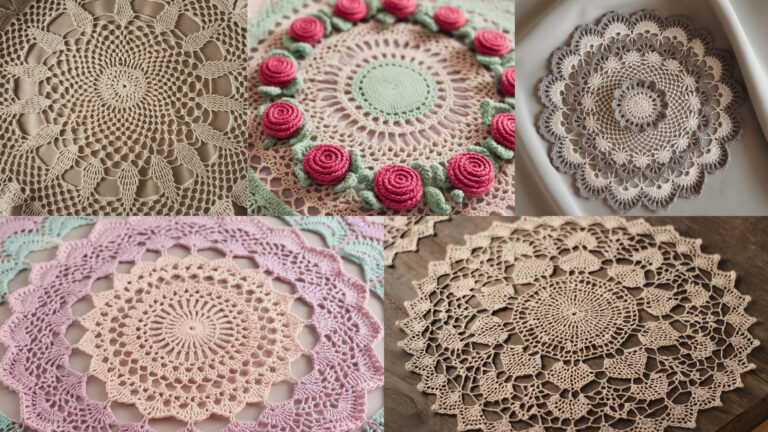
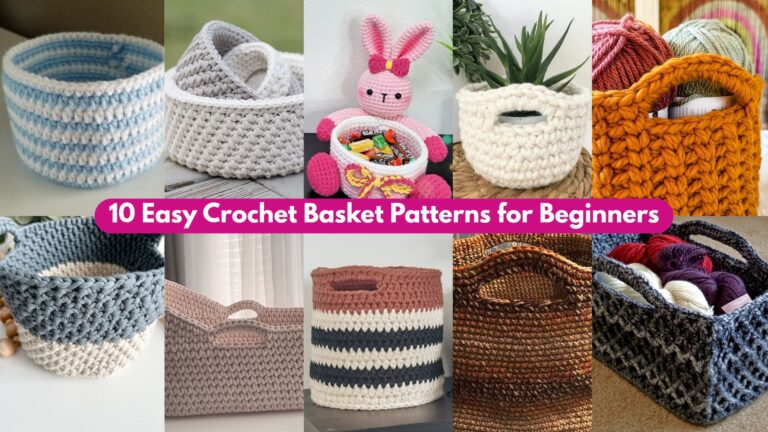

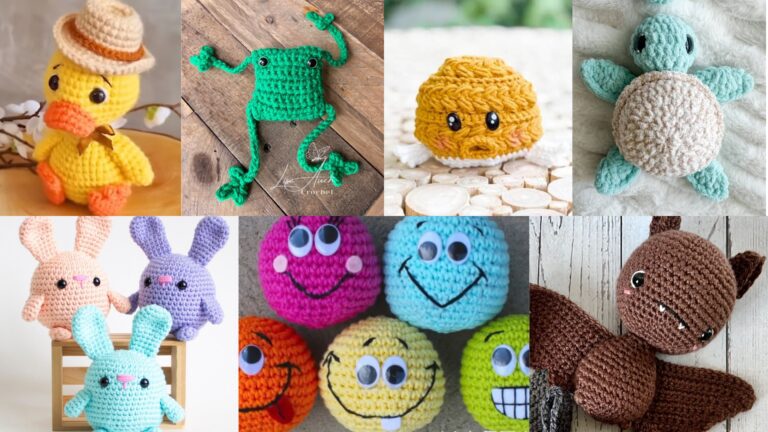

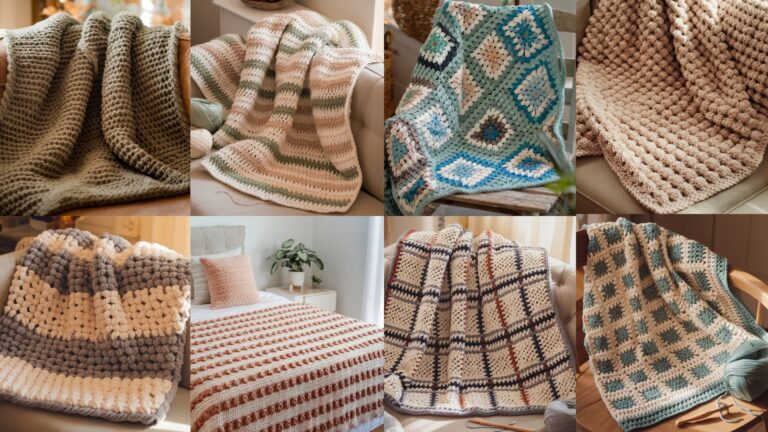
адгезия шпаклёвки
https://adgezia-shpaklevok.ru
гидрофобные добавки
https://vlago-stoykaya-shtukaturka.ru
самовыравнивающиеся смеси
https://teplypol-smesi.ru
теплоизоляция Технониколь
https://energiya-tehnonikol.ru
мобильная версия сайта
http://www.razrabotkaiseo.ru/
Hypertrade
https://cashflowix.com/publications/ai-powered-invoice-processing-revolution-machine-learning-algorithms-transforming-accounts-payable-automation.html
crypto swap aggregator
https://collfinancing.com/publications/blockchain-and-tokenization-in-structured-finance-the-future-of-real-world-asset-securitization.html
ht.xyz
http://www.google.rs/url?q=https://facebook-trends.com/blog/facebook-marketplace-business-strategy-from-setup-to-sales-success.html
hyperliquid trading platform
https://google.co.in/url?q=http://fintechreform.com/publications/shadow-banking-and-non-bank-financial-intermediation-systemic-risks-and-the-imperative-for-comprehensive-reform.html
hyperliquid trading
[url=https://gaming-horse.com/blog/cloud-gaming-the-complete-guide-to-the-future-of-gaming-industry.html]https://gaming-horse.com/blog/cloud-gaming-the-complete-guide-to-the-future-of-gaming-industry.html/[/url]
ht.xyz
https://fintechreform.com/publications/shadow-banking-and-non-bank-financial-intermediation-systemic-risks-and-the-imperative-for-comprehensive-reform.html
ht.xyz
https://home-pinterest.com/blog/pinterest-affiliate-marketing-the-ultimate-monetization-guide-for-content-creators.html
ht.xyz
https://anolink.com/?link=http://insta-limit.com/news/instagram-analytics-mastery-building-data-driven-marketing-dashboards.html
hyperliquid aggregator
https://www.google.mn/url?q=https://link-edin.com/blog/the-psychology-behind-linkedin-algorithm-understanding-user-behavior-for-maximum-organic-reach.html
decentralized trading platform
http://google.com.vc/url?q=http://myfinrights.com/publications/buy-now-pay-later-bnpl-hidden-risks-of-installment-services-and-how-to-protect-your-financial-interests.html
decentralized trading platform
https://net-surfingzone.com/blog/quantum-computing-and-internet-security-preparing-for-the-new-era-of-cryptography.html
swap hyperliquid
http://jump.5ch.net/?http://snap-chat-it.com/blog/snapchat-monetization-the-complete-guide-to-earning-money-as-a-content-creator.html
ht.xyz
https://tech-intell.com/blog/the-philosophy-of-ai-consciousness-can-machines-achieve-sentience-and-what-it-means-for-humanity.html
ht.xyz
https://techfluxpro.com/publications/synthetic-biology-engineering-life-for-industrial-innovation-and-sustainable-future.html
ht.xyz
https://www.teen-social.com/blog/tiktok-creator-economy-complete-revenue-generation-guide-for-content-creators.html
ht.xyz
[url=https://twitter-old.com/blog/x-threads-mastery-advanced-strategies-for-maximum-engagement.html]https://twitter-old.com/blog/x-threads-mastery-advanced-strategies-for-maximum-engagement.html[/url]
ht.xyz
https://vertechsys.com/publications/artificial-intelligence-integration-in-manufacturing-processes-from-theory-to-practical-implementation.html
SEO продвижение сайтов
https://seo-top777.ru
SEO продвижение сайтов
https://google.tl/url?q=http://komandor-club.ru
SEO продвижение сайтов
https://google.sk/url?q=http://ldsp-vrn.ru
SEO продвижение сайтов
https://megamebel812.ru
SEO агентство Москва
[url=https://pharmcatalog.ru]https://pharmcatalog.ru[/url]
SEO агентство Москва
https://google.sh/url?q=http://prodvizhenie-sait.ru
SEO агентство Москва
https://prodvizhenie-saitov-24.ru
SEO агентство Москва
http://www.google.cf/url?q=https://seo-audit-sait.ru
SEO агентство Москва
https://seo-business.ru
SEO продвижение сайтов
http://www.southernclimate.org/?URL=seo-dreams.ru
SEO продвижение сайтов
[url=https://seo-head.ru]http://www.seo-head.ru/[/url]
SEO агентство Москва
https://seo-more.ru
SEO продвижение сайтов
http://www.a-31.de/url?q=http://seo-privat.ru
SEO продвижение сайтов
https://www.seo-top-site.ru/
SEO агентство Москва
https://seo-top.msk.ru
SEO продвижение сайтов
https://seosait-24.ru
SEO агентство Москва
https://seotop-google.ru/
SEO продвижение сайтов
http://www.seymoursimon.com/?URL=seotop-site.ru
SEO продвижение сайтов
https://www.google.mn/url?q=https://sozdanie-website.ru
SEO агентство Москва
[url=http://google.com.ar/url?q=https://продвижение-сайтов-нижний-новгород.рф]https://google.co.zw/url?q=http://продвижение-сайтов-нижний-новгород.рф[/url]
SEO продвижение сайтов
https://раскрутка-сайтов-краснодар.рф
SEO агентство Москва
https://www.rosbooks.ru/go?http://продвижение-сайта-красноярск.рф
SEO агентство Москва
https://www.продвижение-сайта-екб.рф/
SEO продвижение сайтов
http://www.продвижение-сайта-пермь.рф
SEO агентство Москва
[url=https://продвижение-сайтов-ярославль.рф]http://продвижение-сайтов-ярославль.рф/[/url]
SEO продвижение сайтов
https://google.as/url?q=http://продвижение-сайтов-новосибирск.рф
SEO продвижение сайтов
http://www.hellotw.com/gate/big5/продвижение-сайтов-новокузнецк.рф
SEO агентство Москва
http://google.com.kw/url?q=http://продвижение-сайтов-сургут.рф
шины Goodyear купить
http://google.to/url?q=http://goodyear-tyres.ru
шины Goodyear Москва
https://sc.hkexnews.hk/TuniS/goodyeartyres.ru
интернет-магазин шин Yokohama-tyres
https://yokohamatyres.ru
шины Yokohama доставка Россия
https://yokohama-tyres.ru/
шины Continental купить
https://continentaltyres.ru
шины Continental Москва
https://continental-tyres.ru
шины Hankook купить
http://www.hankooktyres.ru
интернет-магазин шин Hankook
http://www.hankook-tyres.ru
шины Toyo купить
[url=https://tyres-toyo.ru]https://tyres-toyo.ru[/url]
интернет-магазин шин
http://www.шины-для-вас-мск.рф
интернет-магазин шин
https://шины-для-вас.рф/
шины купить
http://www.gde-daewoo.ru
интернет-магазин шин
https://sv-margo.ru
интернет-магазин шин
[url=https://teron.online/go/?http://sv-margo.ru]http://google.sc/url?q=http://sv-margo.ru%5B/url%5D
шины купить
http://hr.bjx.com.cn/go.aspx?u=otdelkaidizain.ru
интернет-магазин шин
https://an0nym.xyz/?http://lee-1c.ru
шины купить
https://rrrus.ru
интернет-магазин шин
https://maulanet.ru
шины купить
http://www.shiny-m.ru/
шины купить
https://ug-online.ru
интернет-магазин шин
https://poligrin.ru
жк нова
[url=https://blog-igry.ru]https://blog-igry.ru[/url]
жк нова
http://www.jsfiles.ru/
жилой комплекс остров
https://kinoinemcu.ru
жилой комплекс остров
https://spain-vng.ru/
жилой комплекс символ
[url=https://vng-ispaniya.ru]http://www.vng-ispaniya.ru/[/url]
жк символ
http://vnzh-ispaniya.ru
исправление кифоза у взрослых
https://kifoz-operaciya.ru
витамины для суставов
http://www.sustavy-pitanie.ru
prp инъекции суставы отзывы
https://www.google.hr/url?q=https://prp-sustavy.ru
нейростимуляция позвоночника
http://www.muppetsauderghem.be/?URL=neiro-modulyaciya-boli.ru
нейростимуляция позвоночника
https://neiro-modulyaciya-boli.ru
анализы на артрит
https://rannii-artrit.ru
мрт позвоночника
[url=https://mrt-kt-pozvonochnik.ru]http://mrt-kt-pozvonochnik.ru/[/url]
реабилитация после операции на кисти
https://www.kontraktura-ruki.ru/
как сидеть за компьютером правильно
https://osanka-kompyuter.ru/
восстановление хрящевой ткани
http://regeneraciya-hryasha.ru
https://pohodka-endoprotez.ru/
[url=https://pohodka-endoprotez.ru]http://pohodka-endoprotez.ru/[/url]
артроскопическая хирургия
https://www.triathlon.org/?URL=artroskopiya-travmy.ru
физиотерапия при артрозе
http://www.fizioterapiya-artroz.ru
упражнения для стоп детей
https://www.stopa-detei.ru/
современные методы лечения некроза бедра
https://nekroz-bedra.ru
терапия некроза головки бедра
http://find.games.free.fr/visit.php/ves-i-spina.ru
лишний вес суставы
https://google.us/url?q=http://vrozhdennye-patologii.ru
современные методы лечения ревматоидного артрита
http://www.revmatoidnyi-artrit.ru
шпаклёвка
http://www.adgezia-shpaklevok.ru/
фасадные декоративные покрытия
https://vlago-stoykaya-shtukaturka.ru
энергоэффективные материалы
http://energiya-tehnonikol.ru/
звукопоглощающие материалы
https://zvukoizolyaciya-bazalt.ru